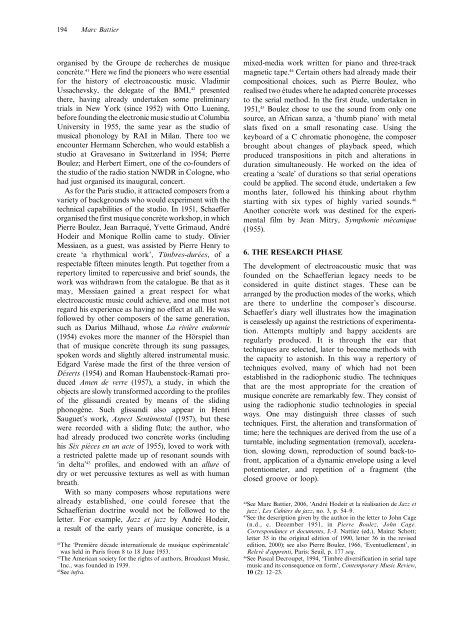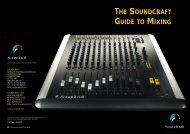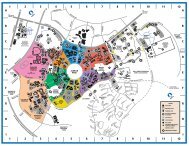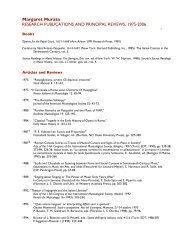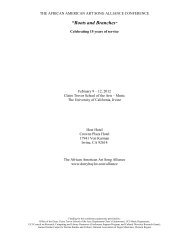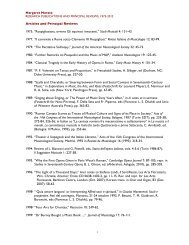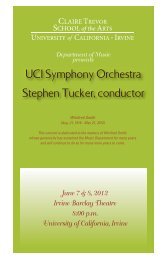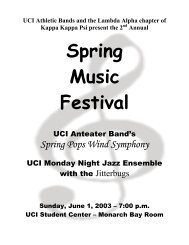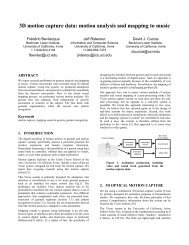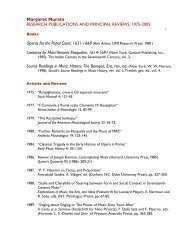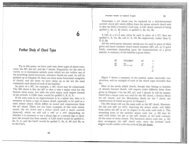What the GRM brought to music: from musique concre`te to ...
What the GRM brought to music: from musique concre`te to ...
What the GRM brought to music: from musique concre`te to ...
You also want an ePaper? Increase the reach of your titles
YUMPU automatically turns print PDFs into web optimized ePapers that Google loves.
194 Marc Battierorganised by <strong>the</strong> Groupe de recherches de <strong>musique</strong>concrète. 41 Here we find <strong>the</strong> pioneers who were essentialfor <strong>the</strong> his<strong>to</strong>ry of electroacoustic <strong>music</strong>. VladimirUssachevsky, <strong>the</strong> delegate of <strong>the</strong> BMI, 42 presented<strong>the</strong>re, having already undertaken some preliminarytrials in New York (since 1952) with Ot<strong>to</strong> Luening,before founding <strong>the</strong> electronic <strong>music</strong> studio at ColumbiaUniversity in 1955, <strong>the</strong> same year as <strong>the</strong> studio of<strong>music</strong>al phonology by RAI in Milan. There <strong>to</strong>o weencounter Hermann Scherchen, who would establish astudio at Gravesano in Switzerland in 1954; PierreBoulez; and Herbert Eimert, one of <strong>the</strong> co-founders of<strong>the</strong> studio of <strong>the</strong> radio station NWDR in Cologne, whohad just organised its inaugural, concert.As for <strong>the</strong> Paris studio, it attracted composers <strong>from</strong> avariety of backgrounds who would experiment with <strong>the</strong>technical capabilities of <strong>the</strong> studio. In 1951, Schaefferorganised <strong>the</strong> first <strong>musique</strong> concrète workshop, in whichPierre Boulez, Jean Barraqué, Yvette Grimaud, AndréHodeir and Monique Rollin came <strong>to</strong> study. OlivierMessiaen, as a guest, was assisted by Pierre Henry <strong>to</strong>create ‘a rhythmical work’, Timbres-durées, of arespectable fifteen minutes length. Put <strong>to</strong>ge<strong>the</strong>r <strong>from</strong> areper<strong>to</strong>ry limited <strong>to</strong> repercussive and brief sounds, <strong>the</strong>work was withdrawn <strong>from</strong> <strong>the</strong> catalogue. Be that as itmay, Messiaen gained a great respect for whatelectroacoustic <strong>music</strong> could achieve, and one must notregard his experience as having no effect at all. He wasfollowed by o<strong>the</strong>r composers of <strong>the</strong> same generation,such as Darius Milhaud, whose La rivière endormie(1954) evokes more <strong>the</strong> manner of <strong>the</strong> Hörspiel thanthat of <strong>musique</strong> concrète through its sung passages,spoken words and slightly altered instrumental <strong>music</strong>.Edgard Varèse made <strong>the</strong> first of <strong>the</strong> three version ofDéserts (1954) and Roman Haubens<strong>to</strong>ck-Ramati producedAmen de verre (1957), a study, in which <strong>the</strong>objects are slowly transformed according <strong>to</strong> <strong>the</strong> profilesof <strong>the</strong> glissandi created by means of <strong>the</strong> slidingphonogène. Such glissandi also appear in HenriSauguet’s work, Aspect Sentimental (1957), but <strong>the</strong>sewere recorded with a sliding flute; <strong>the</strong> author, whohad already produced two concrète works (includinghis Six pièces en un acte of 1955), loved <strong>to</strong> work witha restricted palette made up of resonant sounds with‘in delta’ 43 profiles, and endowed with an allure ofdry or wet percussive textures as well as with humanbreath.With so many composers whose reputations werealready established, one could foresee that <strong>the</strong>Schaefferian doctrine would not be followed <strong>to</strong> <strong>the</strong>letter. For example, Jazz et jazz by André Hodeir,a result of <strong>the</strong> early years of <strong>musique</strong> concrète, is a41The ‘Première décade internationale de <strong>musique</strong> expérimentale’was held in Paris <strong>from</strong> 8 <strong>to</strong> 18 June 1953.42The American society for <strong>the</strong> rights of authors, Broadcast Music,Inc., was founded in 1939.43See infra.mixed-media work written for piano and three-trackmagnetic tape. 44 Certain o<strong>the</strong>rs had already made <strong>the</strong>ircompositional choices, such as Pierre Boulez, whorealised two études where he adapted concrète processes<strong>to</strong> <strong>the</strong> serial method. In <strong>the</strong> first étude, undertaken in1951, 45 Boulez chose <strong>to</strong> use <strong>the</strong> sound <strong>from</strong> only onesource, an African sanza, a ‘thumb piano’ with metalslats fixed on a small resonating case. Using <strong>the</strong>keyboard of a C chromatic phonogène, <strong>the</strong> composer<strong>brought</strong> about changes of playback speed, whichproduced transpositions in pitch and alterations induration simultaneously. He worked on <strong>the</strong> idea ofcreating a ‘scale’ of durations so that serial operationscould be applied. The second étude, undertaken a fewmonths later, followed his thinking about rhythmstarting with six types of highly varied sounds. 46Ano<strong>the</strong>r concrète work was destined for <strong>the</strong> experimentalfilm by Jean Mitry, Symphonie mécanique(1955).6. THE RESEARCH PHASEThe development of electroacoustic <strong>music</strong> that wasfounded on <strong>the</strong> Schaefferian legacy needs <strong>to</strong> beconsidered in quite distinct stages. These can bearranged by <strong>the</strong> production modes of <strong>the</strong> works, whichare <strong>the</strong>re <strong>to</strong> underline <strong>the</strong> composer’s discourse.Schaeffer’s diary well illustrates how <strong>the</strong> imaginationis ceaselessly up against <strong>the</strong> restrictions of experimentation.Attempts multiply and happy accidents areregularly produced. It is through <strong>the</strong> ear thattechniques are selected, later <strong>to</strong> become methods with<strong>the</strong> capacity <strong>to</strong> as<strong>to</strong>nish. In this way a reper<strong>to</strong>ry oftechniques evolved, many of which had not beenestablished in <strong>the</strong> radiophonic studio. The techniquesthat are <strong>the</strong> most appropriate for <strong>the</strong> creation of<strong>musique</strong> concrète are remarkably few. They consist ofusing <strong>the</strong> radiophonic studio technologies in specialways. One may distinguish three classes of suchtechniques. First, <strong>the</strong> alteration and transformation oftime; here <strong>the</strong> techniques are derived <strong>from</strong> <strong>the</strong> use of aturntable, including segmentation (removal), acceleration,slowing down, reproduction of sound back-<strong>to</strong>front,application of a dynamic envelope using a levelpotentiometer, and repetition of a fragment (<strong>the</strong>closed groove or loop).44See Marc Battier, 2006, ‘André Hodeir et la réalisation de Jazz etjazz’, Les Cahiers du jazz, no. 3, p. 54–9.45See <strong>the</strong> description given by <strong>the</strong> author in <strong>the</strong> letter <strong>to</strong> John Cage(n.d., c. December 1951, in Pierre Boulez, John Cage.Correspondance et documents, J.-J. Nattiez (ed.), Mainz: Schott;letter 35 in <strong>the</strong> original edition of 1990, letter 36 in <strong>the</strong> revisededition, 2000); see also Pierre Boulez, 1966, ‘Eventuellement’, inRelevé d’apprenti, Paris: Seuil, p. 177 seq.46See Pascal Decroupet, 1994, ‘Timbre diversification in serial tape<strong>music</strong> and its consequence on form’, Contemporary Music Review,10 (2): 12–23.


